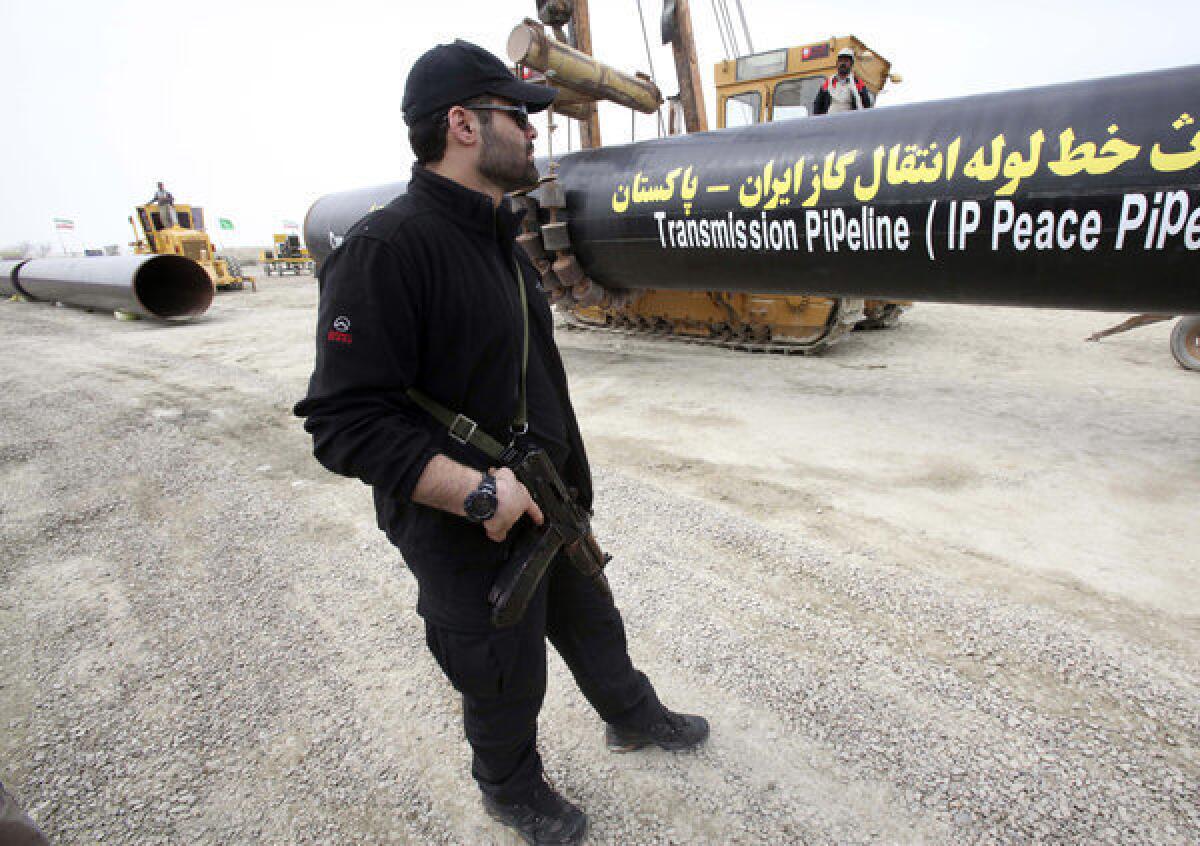Pakistan, Iran launch controversial gas pipeline project

- Share via
ISLAMABAD, Pakistan -- Work formally began Monday on a controversial pipeline that would feed energy-starved Pakistan natural gas from Iran, a project that has drawn stern warnings from the U.S. of possible sanctions against Islamabad if the South Asian nation doesn’t reverse course.
President Asif Ali Zardari led a 300-member delegation from Islamabad to Iran, where officials from both countries attended a ceremony inaugurating the project. The 1,244-mile pipeline would each day transport more than 750 million cubic feet of natural gas to Pakistan from Iran’s South Pars gas field in the Persian Gulf.
Iran is nearing completion of the segment of the pipeline on its side of the border with Pakistan. Monday’s ceremony marked the beginning of work on the Pakistani segment, which will start at the Iranian town of Chahbahar near the border.
Pipeline talks between the countries stretch back as far as 1994. Pakistan produces only 30% of the natural gas it needs, while Iran has the world’s second-largest natural gas reserves. Many of Pakistan’s factories and its transport system rely heavily on natural gas -- about 21% of the country’s vehicles run on compressed natural gas.
The U.S. has repeatedly warned Islamabad that forging ahead with the pipeline project could expose Pakistan to economic penalties under the Iran Sanctions Act. The law is aimed at curbing what the West believes are Tehran’s attempts to build a nuclear weapons program, and imposes sanctions on entities that engage in certain business activities and energy sector-related transactions with Iran. Tehran denies that it is pursuing nuclear weapons, and insists its nuclear program is meant for peaceful, civilian purposes only.
Speaking at the project’s inauguration in Chahbahar, Iranian President Mahmoud Ahmadinejad, in remarks broadcast on Pakistani television, called the pipeline a symbol of Pakistan’s and Iran’s independence from “those who only aim to humiliate us, and break us apart, and dominate us,” a clear reference to the U.S.
“I’m confident that no foreign element will be able to affect our historic and brotherly relations,” he said.
U.S. officials have tried to convince leaders in Islamabad that Washington can help solve Pakistan’s energy crisis through the construction of hydroelectric dams and other projects that beef up the country’s power grid.
“We really think there are other long-term solutions to Pakistan’s energy needs, and so we’ve been assisting as a government to contribute to the alleviation of the energy crisis in Pakistan,” State Department spokesman Patrick Ventrell told reporters at a briefing in Washington in late February. “It’s in their best interest to avoid any sanctionable activity.”
Ventrell said it wasn’t clear whether the act of building the pipeline would constitution a violation of the Iran Sanctions Act.
So far, Pakistani officials have tried to appear unfazed by threats of possible sanctions.
“We are not in a fix,” Foreign Ministry spokesman Moazzam Khan said at a briefing last week. “It is in our national interest to go ahead with this project. We know about [Washington’s] concerns, but we expect and hope that all our friends, including the U.S., would show more understanding on this issue.”
Looming as a bigger hurdle for Pakistan is its ability to finance its segment of the project, which is expected to cost as much as $1.5 billion. Iran has agreed to provide a $500-million loan to help pay for the work, but it remains unclear whether Pakistan can succeed in raising the additional $1 billion through surcharges tacked on to electricity bills. Many Pakistani power consumers don’t pay their bills, and utility companies have struggled to find ways to clamp down on delinquent customers.
ALSO:
U.N. peacekeepers in Syria to be freed
Under spotlight, cardinals pray on last Sunday before conclave
Western governments say Nigerian extremists executed 7 hostages
More to Read
Sign up for Essential California
The most important California stories and recommendations in your inbox every morning.
You may occasionally receive promotional content from the Los Angeles Times.










